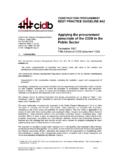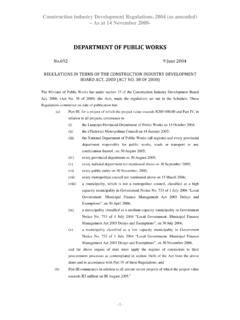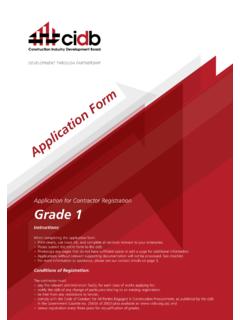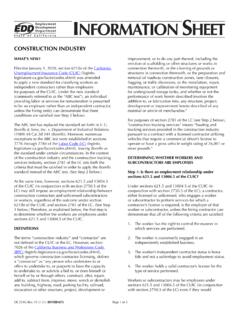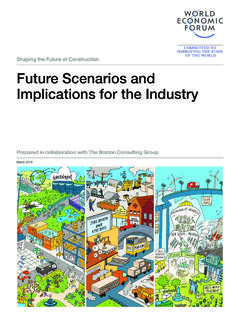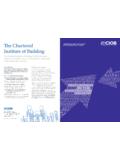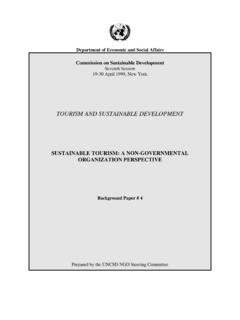Transcription of works - CIDB
1 construction PROCUREMENT. BEST PRACTICE GUIDELINE #C2 Choosing an appropriate form of contract for construction industry development Board engineering and construction Pretoria - Head Office Tel: 012 482 7200 works Fraudline: 0800 11 24 32. Call Centre: 0860 103 353. E-mail: September 2005. Second edition of CIDB document 1010. 1. Background The Green Paper on Creating an Enabling Environment for Reconstruction, Growth and development in the construction industry has a vision for a construction industry policy and strategy that promotes stability, fosters economic growth and international competitiveness, creates sustainable employment and addresses historic imbalances as it generates new industry capacity.
2 This paper, when considering what is needed to promote new industry capacity and the emerging sector calls for, amongst others: the simplification of contract documents to enable them to be more readily comprehensible, particularly to persons whose mother tongue is not English;. the streamlining of payment procedures and surety arrangements; and the continued review of contract documentation to ensure that conditions do not constitute barriers to increased participation. It also suggests that a partnering approach within the framework of public sector procurement may enhance industry performance. In order to make procurement reform effective in the manner intended, employers in the engineering and construction industry need, amongst others, to revisit the standard forms of contract which are in use.
3 The current approach of having, probably, as many standard forms of contract as there are disciplines in the industry , together with a considerable number of in-house forms of contract, neither makes for efficiency nor does it enable a focussed approach to skills training necessary for development and growth. This applies to both private and public sector work. Whilst the ideal of standardisation on one system of standard forms of contracts for all engineering and construction works in South Africa is, probably, just as illogical as it is for each client to have its own form of contract; a balance has to be found between these two extremes.
4 2. Considerations in reducing the number of forms of contract in use The two fundamental considerations in the reducing the number of forms of contract in use in South Africa are: standardisation; and Best Practice Guideline C2: Choosing an appropriate form of contract for engineering and construction works Page 1. September, 2005: Edition 2 of CIDB document 1010. having documentation capable of catering for a wide range of client requirements. The first stage in any initiative aimed at standardisation is to limit the choice of the forms of contract. The construction industry , together with the Interministerial Task Team for construction industry development , based on an evaluation of a range of forms of contract against a set of criteria (see Annexure 1), drew up a list of documents published by four different bodies in 2000 to limit the number of forms of contract in 1.
5 Use . This list was compiled to ensure that clients could deliver projects using a wide range of contracting and pricing strategies which are based on sound drafting practices. Obviously, forms of contract which apply only to specific subsectors of the industry , eg the roads sector, were not included in the list. The recommended forms of contract are those contained in the following series of documents: FIDIC (French acronym for International Federation of Consulting Engineers) 1999. General Conditions of Contract for construction works (GCC 2004). JBCC Series 2000. NEC3 family of standard contracts The second stage in standardisation is to provide compatibility between standard forms of contract and other standard documents used in procurements, eg standards relating to the scope of the work, tender data and methods of measurement and payment.
6 Ideally the recommended forms of contracts should be able to be used with a range of standard procurement documents and should not be structured around the 2. use of specific standards and systems of measurement. FIDIC, NEC3 and GCC are forms of contract that can be used on all types of engineering and construction contracts. JBCC 2000 is, however, confined to building works . The FIDIC, NEC3 and JBCC series of documents contain short versions of engineering and construction works contracts. The four series of documents collectively cover the commonly encountered contracting strategies that are currently being pursued internationally.
7 There is no doubt that the reduction in the prolific number of forms of contract in use in South Africa to the aforementioned four series of documents will assist in the eliminating many of the inefficiencies and losses associated with having to interpret the many varied approaches used to establish the risks, liabilities and obligations of the parties to a contract and the administration procedures associated therewith. 3. An overview of the FIDIC suite of documents FIDIC (French acronym for the International Federation of Consulting Engineers) which was founded in 1913 by three national associations of consulting engineers within Europe and currently has membership from more than 60 countries from all parts of the globe, is known throughout the world for producing standard forms of contract for civil engineering construction , and mechanical and electrical plant.
8 In 1999. FIDIC extended its ambit into other disciplines, with the publication of first editions of a new family of contracts comprising four new standard forms of contract: 1. Focus group 6 of the Interministerial Task Team for construction industry development recommended that the public sector should procure engineering and construction works in terms of a limited range of standard and approved procurement documents, and which, as far as possible, comply with the provisions of Best Practice Guide #2: Features of a modern form of engineering and construction contract (See Annexure 1). The use of in house documents and / or the incorporation of substantial variations to the standard forms of contract must be avoided.
9 Best Practice Guide #2: Features of a modern form of engineering and construction works contract sets out the essential and desirable criteria, as well as the rationale for such criteria, for acceptable forms of engineering and construction works contracts in South Africa. This guide enabled decisions to be taken regarding which forms of contracts should be used in South Africa. The criteria which are presented also informs the development and direction of new forms of contract and the revision of existing forms of contract. (See Annexure 1). 2. Focus group 6 of the Interministerial Task Team for construction industry development made several recommendations regarding the formatting and compilation of procurement documents.
10 This work informed the development of SANS 10403 (Formatting and Compilation of construction Procurement Documents) by the StanSA Technical Committee for construction Standards. Best Practice Guideline C2: Choosing an appropriate form of contract for engineering and construction works Page 2. September, 2005: Edition 2 of CIDB document 1010. Conditions of Contract for construction ( Red Book ). Conditions of Contract for Plant and Design-Build ( Yellow Book ). Conditions of Contract for EPC/Turnkey Projects ( Silver Book ). Short Form of Contract ( Green Book ). These forms of contract are recommended for general use where tenders are invited.
